InsurTech, where insurance and technology converge, has transformed how we access and experience insurance services. Technology now plays a crucial role for insurance companies and customers, giving rise to innovative insurtech platforms that reshape the industry. This evolution is marked by improved efficiency, increased accessibility, and a more personalized approach to insurance offerings.
Aloa, an expert in software outsourcing, recognizes the significant impact of insurtech on the insurance industry. It highlights the potential of this technology to improve operational efficiency and contribute substantially to your overall success. Embracing insurance tech can redefine how you approach insurance, leading to transformative outcomes and enhanced competitiveness in the market.
In this blog, we'll explore its use cases and provide tips on insurance technology development. We'll also discuss its significance in modernizing insurance processes, improving customer experiences, and fostering innovation in the industry. Understanding its potential can help you thrive in the constantly evolving insurance tech landscape.
Afterward, you'll understand how to leverage insurtech solutions effectively in your insurance operations. Armed with practical insights and actionable strategies, you'll be ready to navigate the complexities of this landscape and seize new opportunities for growth and innovation in your insurance business.
Let’s get started!
What Is InsurTech?
InsurTech, short for insurance technology, refers to using technology to innovate and improve processes within the insurance industry. It involves leveraging advancements such as artificial intelligence, big data analytics, machine learning, and digital platforms to streamline operations, enhance customer experiences, and develop new insurance products and services.
Through collaboration with traditional insurers and regulatory bodies, insurtech endeavors to foster a more agile and responsive insurance industry capable of adapting to changing market dynamics and customer preferences. This collaborative effort paves the way for a transformative landscape where innovation and customer-centricity drive the future of insurance.
Use Cases of InsurTech in 2024
InsurTech has revolutionized insurance operations, enhancing policy management and claims processing efficiency. Its ongoing advancements broaden its applications across the insurance industry, streamlining processes to the advantage of both providers and policyholders. Here are some critical use cases where it is making a significant impact:
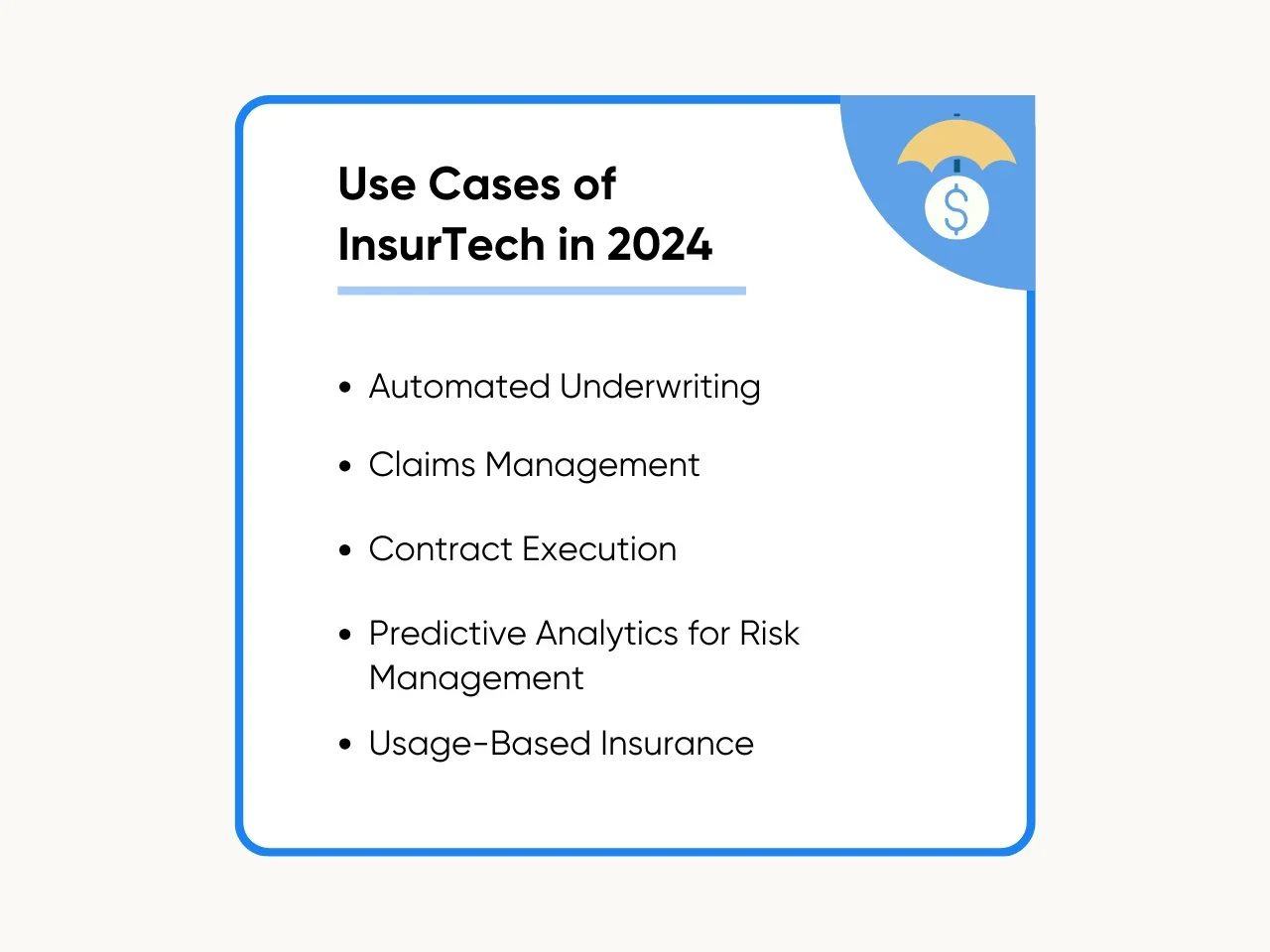
Automated Underwriting
Automated underwriting involves using technology, data analytics, and algorithms to assess insurance applications without human intervention. InsurTech companies are revolutionizing underwriting processes in the insurance industry through data collection, advanced analytics, and fintech solutions.
With the ability to enhance underwriting accuracy, improve workflows, and deliver personalized insurance products, here's how insurtech is improving underwriting processes:
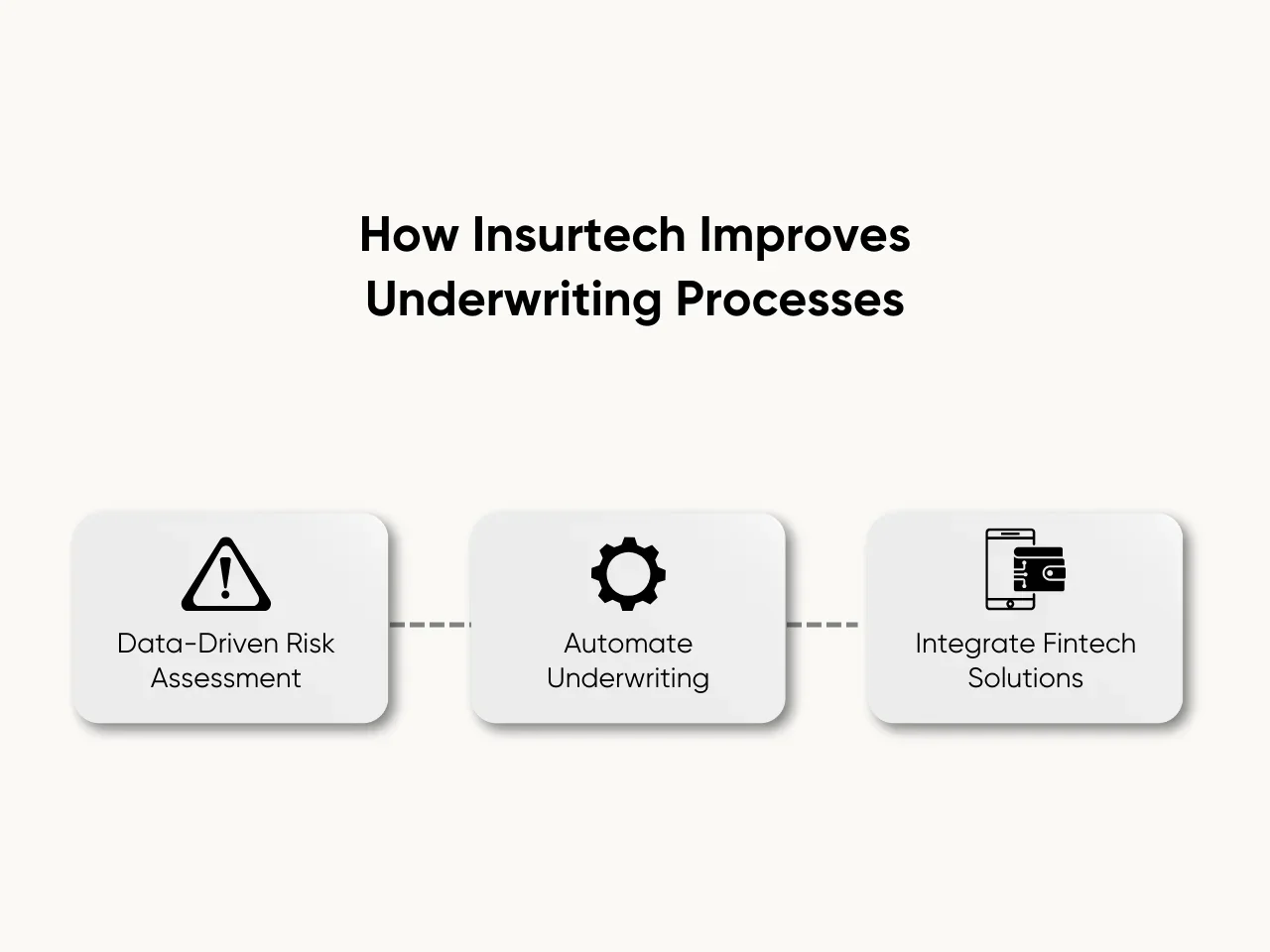
- Data-Driven Risk Assessment: Leverages big data and advanced analytics to analyze customer data, enabling insurers to assess risks more accurately and tailor insurance offerings to individual needs.
- Automation of Underwriting Workflows: Companies automate various aspects of underwriting, such as data collection, risk scoring, policy generation, and optimizing processes, ensuring faster, more informed decision-making.
- Incorporation of Fintech Solutions: Businesses integrate fintech solutions, such as online insurance marketplaces, automated quotations, and instant policy issuance, simplifying the underwriting process and creating a smooth customer experience within the fintech industry.
Claims Management
Insurtech enhances claims management through automation, data analytics, digital platforms, and predictive modeling. These tools help insurers process claims more efficiently, reduce costs, enhance accuracy, and improve customer experience. Explore how it is changing the landscape of claims management:
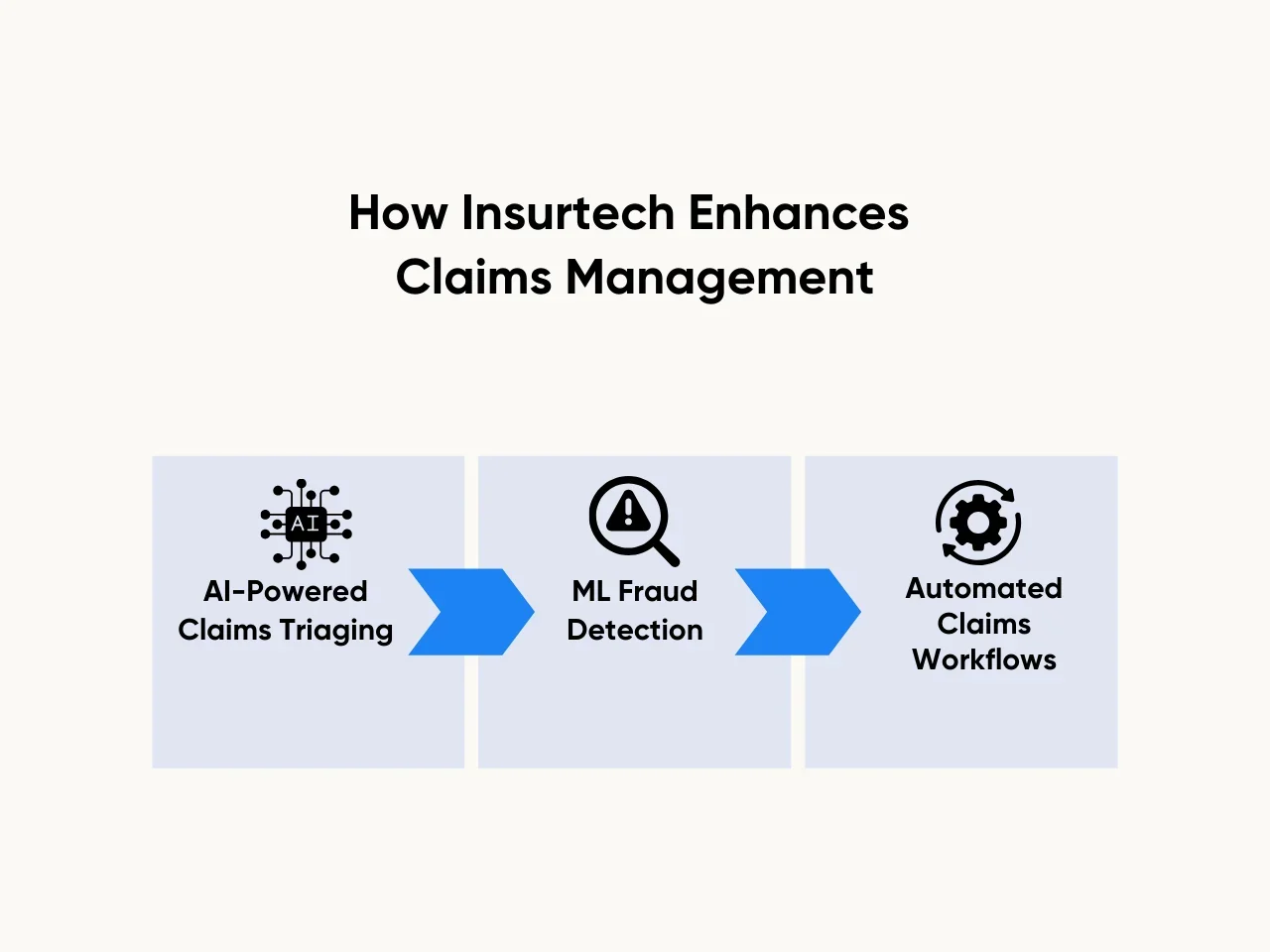
- AI-Powered Claims Triaging: AI algorithms are used to assess the severity of claims, categorize them, and assign them to the appropriate claims adjusters, improving efficiency and reducing response times.
- Machine Learning for Fraud Detection: Machine learning models analyze patterns and anomalies in claims data to identify potential instances of fraud, streamlining the claims investigation process and minimizing fraudulent claims.
- Automated claims workflows: Companies leverage workflows and automation to streamline the entire claims lifecycle, from filing a claim to settlement, reducing manual errors, and improving speed and accuracy.
Contract Execution
Contract execution typically involves complex paperwork, lengthy processes, and manual signatures. However, insurtech companies are simplifying this process through technologies like smart contracts, blockchain, and automation. Here's how it facilitates contract execution:
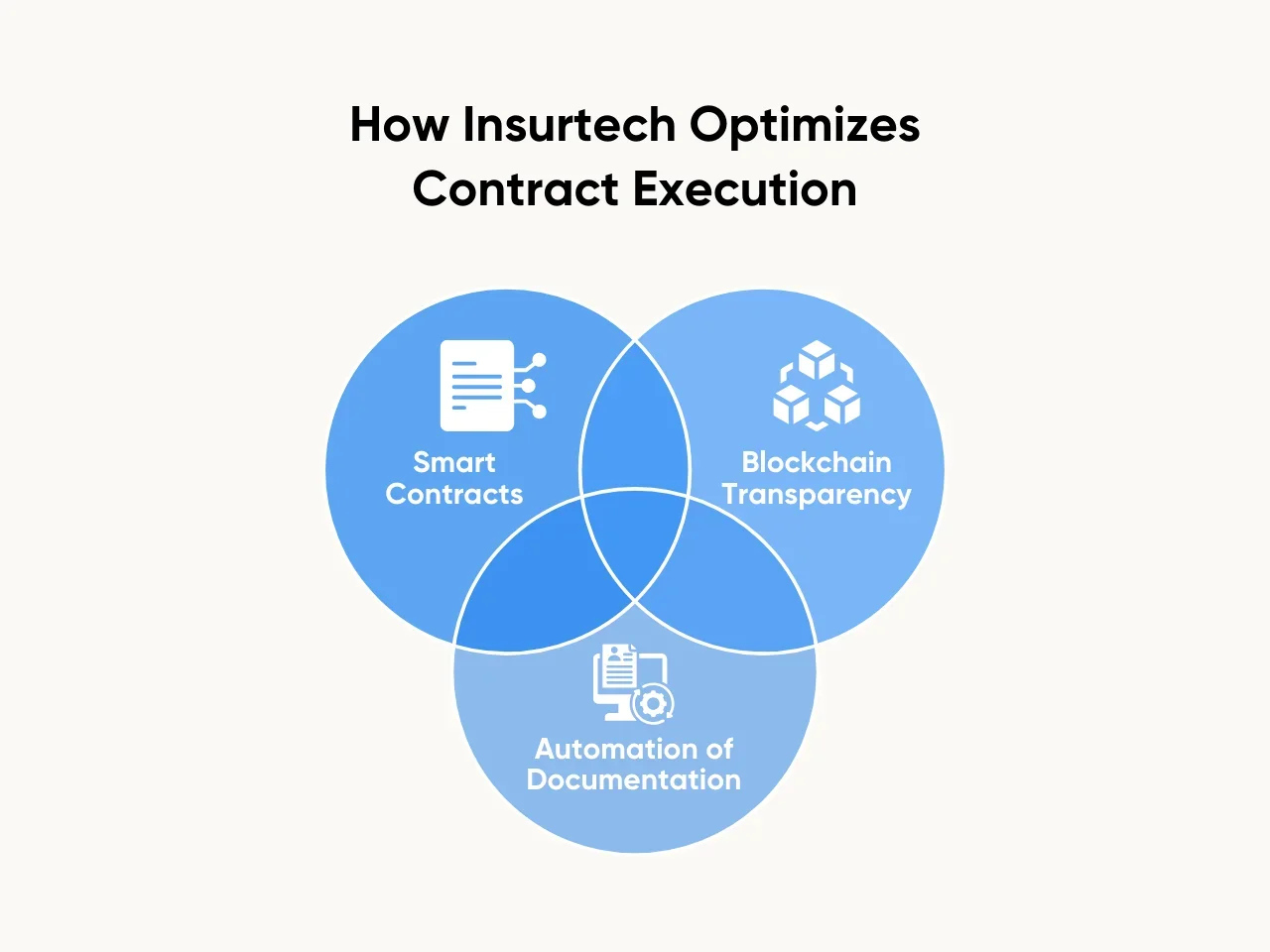
- Smart Contracts: Leverages intelligent contract technology powered by blockchain to automate and enforce contract terms, conditions, and settlements. Smart contracts eliminate manual interventions, reducing administrative overheads and complexities.
- Blockchain-Powered Transparency: Ensures secure, transparent, and tamper-proof insurance transactions, enhancing data integrity, privacy, and trust. Companies leverage blockchain to create immutable records of insurance contracts, facilitating seamless communication and reducing disputes.
- Automation of Documentation: Streamlines policy issuance, documentation, and management through automation, eliminating the need for manual paperwork, manual signatures, and extensive processing time.
Predictive Analytics for Risk Management
Leveraging data analytics in insurance technology forecasts and mitigates risks, improving insurance operations. Advanced technologies enable personalized risk management solutions, enhancing risk assessment and minimizing threats.
Real-time risk monitoring and actionable insights from insurance technology facilitate proactive risk mitigation strategies, ensuring effective risk mitigation for insurance firms. This innovative approach sets a new standard for risk management, shaping the insurance industry's future.
Usage-Based Insurance (UBI)
Usage-based insurance (UBI) is a technology-driven approach that collects and analyzes data on driving behavior to customize insurance premiums based on actual usage and risk. This strategy promotes safer driving habits, which ultimately reduces the number of accidents and claims filed.
UBI will become even more prevalent with the expected surge of IoT and connected cars. The increasing number of connected vehicles will result in an influx of driving data, which can be used to provide personalized insurance premiums to drivers based on their driving habits.
How To Develop Successful InsurTech In 2024
Developing a successful insurtech in 2024 requires a deep understanding of insurance industry dynamics and cutting-edge technological trends. It is essential to master core concepts in its development and become proficient in relevant technologies. Explore our comprehensive guide on developing successful insurance tech solutions in 2024:

Step 1: Identify Market Needs
First, it's crucial to grasp the insurance industry's prevailing pain points and challenges. Pinpoint areas where technological interventions can enhance efficiency, elevate customer experience, and streamline risk management processes. Here are some critical factors to consider as you dive into this process:
- Pain Points and Challenges: Understand the existing pain points and challenges insurance companies and customers face. These may include complex and time-consuming processes, more transparency, high premiums, slow claims processing, and limited product offerings.
- Customer Experience: Evaluate customer experience across various touchpoints, including purchasing insurance, filing claims, customer support, and policy management.
- Efficiency Improvement: Assess opportunities to enhance operational efficiency within insurance companies.
- Technology Integration: Identify areas where technology solutions like artificial intelligence, machine learning, data analytics, blockchain, IoT, and insurance software solutions can be merged to fuel innovation and efficiency gains within the insurance sector.
- Risk Management: Understand the evolving landscape of risks insurance companies and policyholders face. By staying vigilant and proactive, insurers can effectively mitigate potential threats and enhance the resilience of their operations.
- Competitive Landscape: Analyze the competitive landscape within the insurance industry, including both traditional insurers and startups. Identify gaps in the market where innovative solutions can differentiate your offering and capture market share.
Step 2: Focus on Customer Experience
Building solutions prioritizing user experience is key to achieving customer satisfaction. Make it easy for customers to purchase insurance, file claims, and communicate with your company through intuitive digital platforms and mobile apps. Here are several key considerations to prioritize as you build solutions to enhance user experience and customer satisfaction:
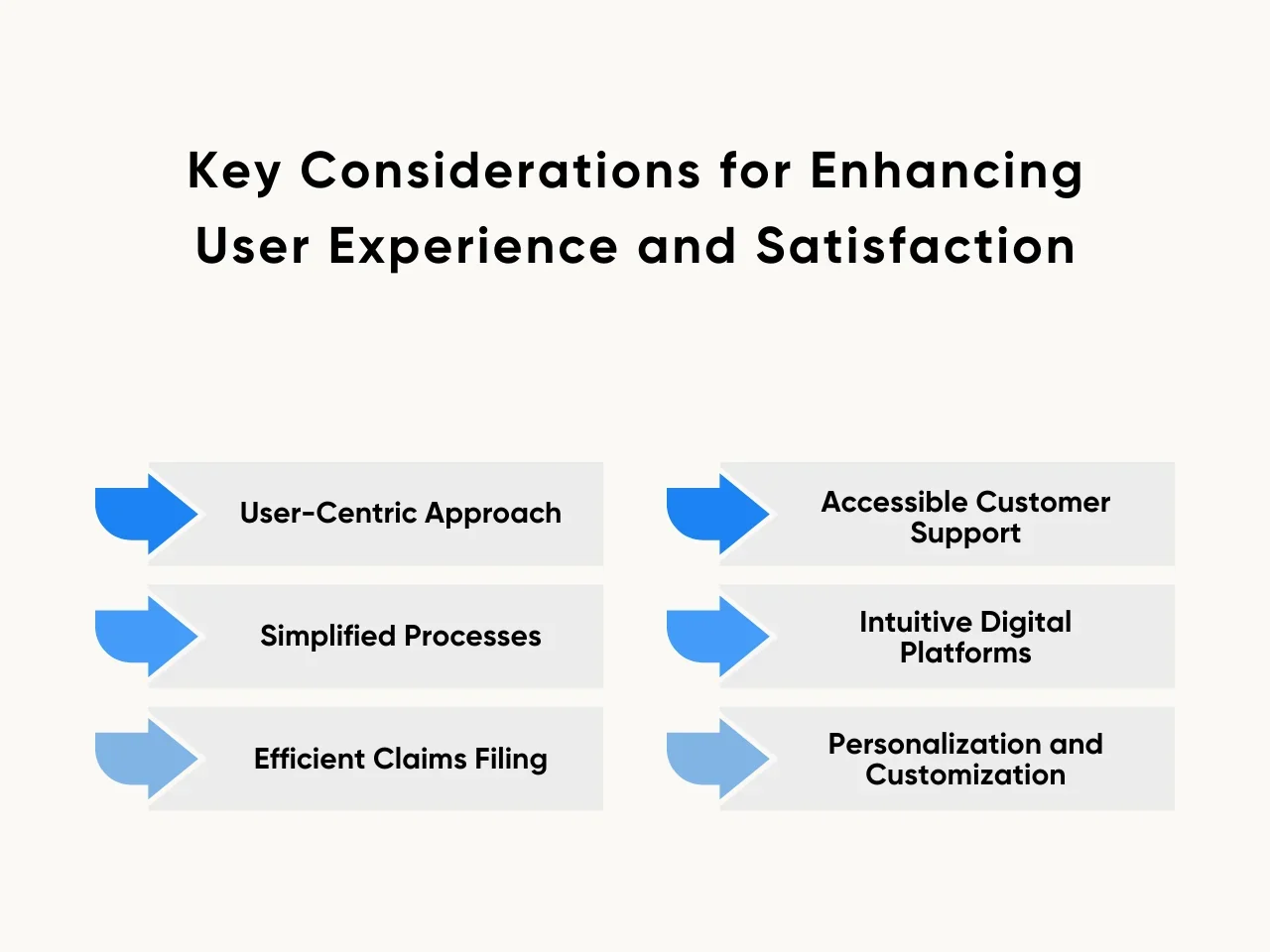
- User-Centric Approach: Prioritize the needs and preferences of customers throughout the design and development process. Understand their pain points, expectations, and behaviors to create solutions that resonate with them.
- Simplified Processes: Optimize the insurance purchasing process to make it quick, intuitive, and hassle-free. Minimize paperwork, simplify language, and offer transparent pricing to enhance the user experience.
- Efficient Claims Filing: Develop efficient and user-friendly channels for filing insurance claims. Empower customers to submit claims easily through digital platforms, provide clear instructions, and respond promptly to inquiries.
- Accessible Customer Support: Offer accessible and responsive customer support channels. Utilize AI-powered chatbots, live chat features, and 24/7 helplines to assist customers with inquiries, policy changes, and claims assistance.
- Intuitive Digital Platforms: Invest in intuitive digital platforms and mobile apps that enable customers to manage their policies, track claims, and access relevant information conveniently. Ensure these platforms are user-friendly, secure, and compatible across various devices.
- Personalization and Customization: Customize insurance products and services to meet individual customers' specific needs and preferences. Leverage data analytics and customer insights to personalize offerings, pricing, and communication strategies.
Step 3: Utilize Advanced Technologies
Once you’re done building solutions to enhance customer experience, embrace the cutting-edge capabilities of emerging technologies like AI and machine learning, blockchain, and the Internet of Things (IoT). Leveraging these advancements revolutionizes traditional insurance practices and helps you stay ahead in the dynamic insurtech landscape. Here's a breakdown of technologies that you can utilize:
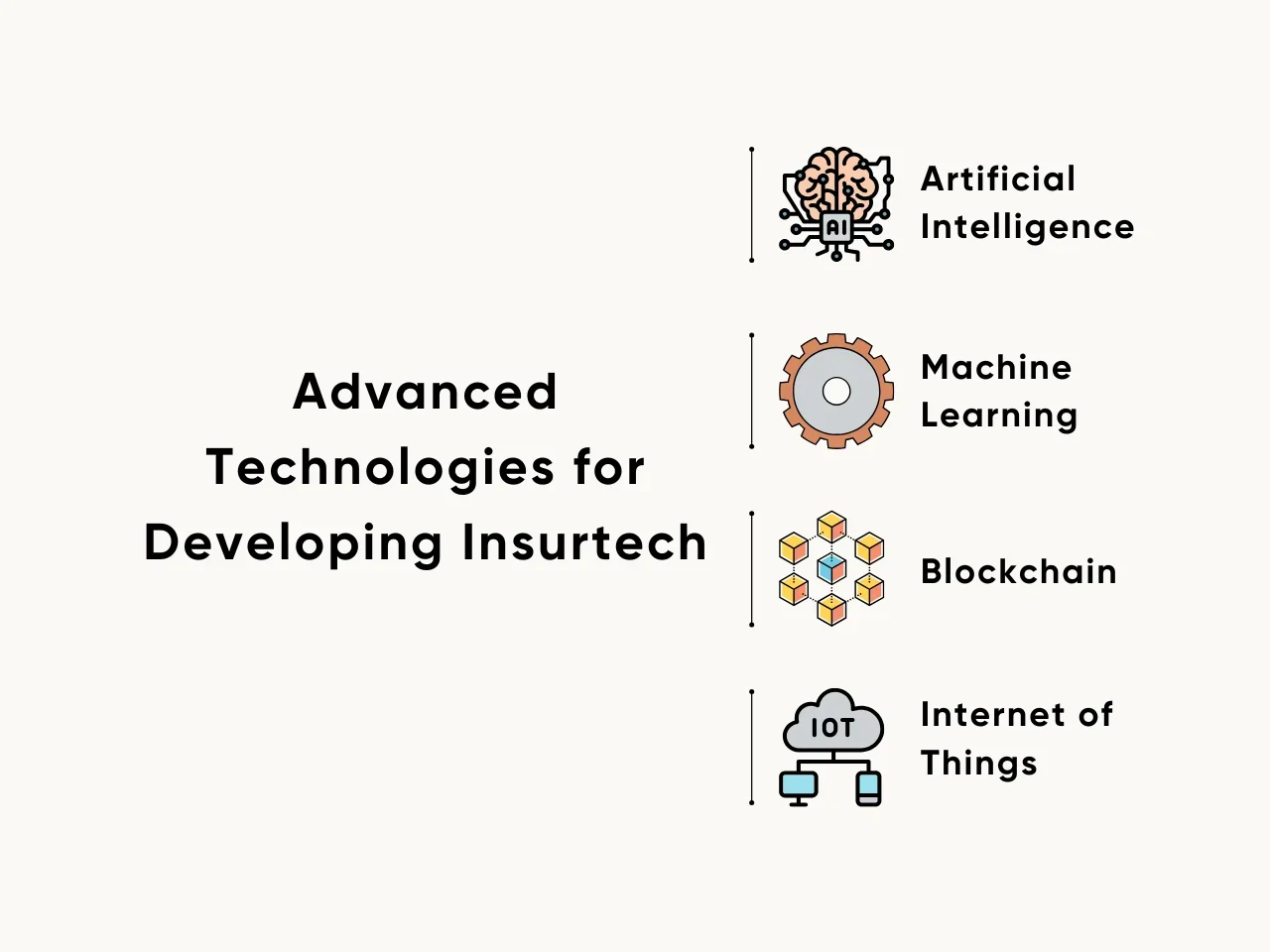
- Artificial Intelligence (AI): AI systems can automate repetitive tasks, make predictions, and streamline decision-making processes. For instance, AI-powered algorithms can analyze vast datasets to identify patterns, trends, and anomalies that may indicate potential risks or opportunities.
- Machine Learning (ML): ML algorithms can learn from data and improve performance over time without being explicitly programmed. ML techniques can enhance risk assessment by analyzing historical data, identifying complex relationships, and predicting future outcomes more accurately.
- Blockchain: Blockchain technology offers decentralized and secure record-keeping capabilities, which can enhance transparency, traceability, and integrity in various processes. In risk assessment, blockchain can create immutable audit trails, verify the authenticity of data, and ensure data integrity across different parties.
- Internet of Things (IoT): IoT devices gather real-time data from sensors, actuators, and connected devices. Integrating IoT data into risk assessment processes helps organizations gather timely insights, monitor operational parameters, and identify potential risks or vulnerabilities.
Step 4: Data Analytics and Personalization
Utilizing data analytics to investigate customer behavior, preferences, and risk profiles is vital to identify market opportunities and develop marketing strategies. Start by creating customized insurance products and pricing models that cater to individual needs. Afterward, leverage advanced algorithms to analyze large datasets, uncover patterns, and predict future trends.
In addition, insurers can reduce risks, combat fraud, and simplify claims by leveraging data analytics and personalization. Analyzing customer data enables targeted marketing and identifies new market segments, fostering sustainable growth and competitiveness in the insurance industry.
Step 5: Compliance and Regulation
Stay informed of regulatory requirements and compliance standards in the insurance industry. Ensure your insurtech solution adheres to all applicable laws and regulations to build trust with customers and regulators.
By adhering to compliance protocols, you mitigate risks and demonstrate your commitment to maintaining ethical and legal standards in the industry. It is essential to continuously monitor and adapt to regulation changes to uphold the integrity and reliability of your insurance tech platform.
Step 6: Partnerships and Collaboration
Collaborate with traditional insurance companies, reinsurers, technology providers, and startups to leverage expertise, resources, and market reach. Partnering with established players can help accelerate growth and mitigate risks.
By forming strategic alliances, you can access complementary strengths, tap into new markets, and foster innovation through shared knowledge and resources. These partnerships enable mutual benefits, driving the development of tailored solutions and enhancing the overall competitiveness of your venture in the dynamic insurance landscape.
Step 7: Agile Development and Iteration
Adopt agile development methodologies to quickly iterate on your product based on user feedback and market insights. Continuously refine and improve your insurance tech solution to stay ahead of competitors and meet evolving customer needs.
Agile methodologies enable incremental value delivery and flexibility in response to changing requirements and market dynamics. Embracing agile principles empowers teams to collaborate closely, prioritize features effectively, and deliver high-quality solutions that resonate with users.
Importance of InsurTech Today
InsurTech has become increasingly important for insurance companies striving to stay competitive in an evolving digital landscape. Insurance tech solutions allow insurance companies to enhance customer experience, streamline operations, and drive innovation. Here are some reasons that underscore its significance in today's insurance industry:
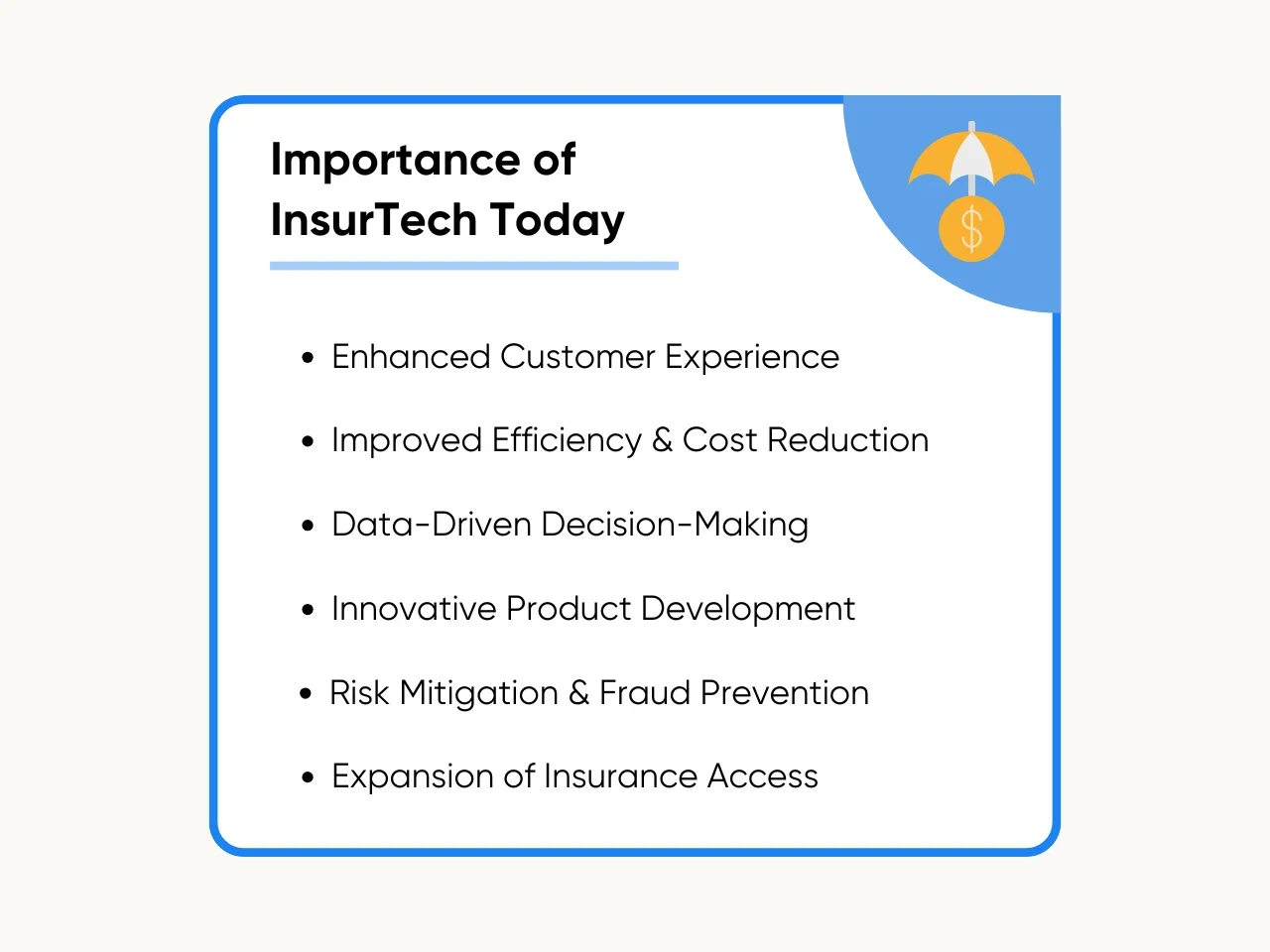
Enhanced Customer Experience
InsurTech enhances customer interactions with smooth, personalized experiences throughout policy purchase and claims processing. Leveraging AI and machine learning, it swiftly assesses risks and offers tailored insurance solutions. Digital platforms provided by insurtech firms enable easy online policy and claim management.
Real-time updates through insurance tech make the claims process transparent and efficient, resulting in heightened customer satisfaction and loyalty, benefiting both customers and insurance companies. Agile approaches foster innovation, allowing startups and insurers to introduce new coverage options and services.
Improved Efficiency and Cost Reduction
InsurTech is pivotal in streamlining insurance processes, reducing administrative costs, and improving efficiency. Through the automation of underwriting and claims processing, manual labor is minimized, saving both time and money.
Furthermore, it enables insurers to provide more personalized products and services, elevating the customer experience. Leveraging AI and data analytics reduces risk and prevents potential losses.
Data-Driven Decision-Making
Insurance technology employs advanced technology and data analytics to drive decision-making, improving the speed and accuracy of informed choices. Identifying and addressing workflow inefficiencies ensures better risk assessment and fraud detection, ultimately enhancing operational efficiency and customer satisfaction.
Data analysis allows insurers to offer customers personalized insurance products and services, optimizing the overall customer experience. This approach streamlines operations and elevates risk assessment, fraud prevention, and customer satisfaction, positioning insurtech as the next generation of innovation in the insurance industry.
Innovative Product Development
Insurance tech facilitates efficient and rapid product development, addressing shifting market needs and consumer preferences with agility. Through custom software development, AI, and machine learning tools, insurers can identify untapped markets and tailor new products accordingly.
Additionally, it enables personalized insurance offerings that align with individual requirements and preferences. Leveraging technology minimizes the time and costs involved in traditional product development processes, enhancing operational efficiency and customer satisfaction.
Risk Mitigation and Fraud Prevention
InsurTech solutions employ sophisticated machine learning algorithms to assess risk factors and detect fraudulent activities in real-time. Insurers can mitigate risks more effectively by continuously monitoring transactions and customer behavior patterns and safeguarding against potential losses.
By integrating sophisticated technologies, insurtech efficiently identifies and prevents fraudulent activities within the insurance sector. Real-time data analysis allows swift detection of anomalies, while automated claims processing reduces errors and fraud risks. Overall, it improves transparency and efficiency for insurers and policyholders alike.
Expansion of Insurance Access
InsurTech has the potential to expand insurance access to underserved markets and demographics. By leveraging mobile technology and digital platforms, insurtech companies can reach customers in remote locations or those with limited access to traditional insurance channels, promoting financial inclusion and resilience against unforeseen events.
Furthermore, its ability to streamline processes and reduce administrative overhead can lower costs for insurers and policyholders. This cost-effectiveness opens up avenues for more affordable insurance options, making coverage accessible to a broader range of individuals and businesses.
Key Takeaway
InsurTech ecosystem revolutionizes the insurance industry by interconnecting technologies, platforms, and services to streamline processes and effectively serve customers. It empowers startups, innovators, and developers with insurtech tools, data, and infrastructure for designing, deploying, and analyzing insurance solutions, fostering collaboration and innovation in the insurance sector.
Understanding its inner workings unveils the strategies for effectively serving customers and optimizing insurance performance. It reveals how algorithms analyze vast data sets to identify risk patterns, how analytics refine underwriting processes, and how machine learning adapts to changing market dynamics.
Sign up for our email list and explore other blogs to stay updated on the latest developments within this industry. Our dedicated team is here to assist you in bringing your insurance concepts to life. Let's collaborate to drive innovation and success in insurance technology in 2024.

